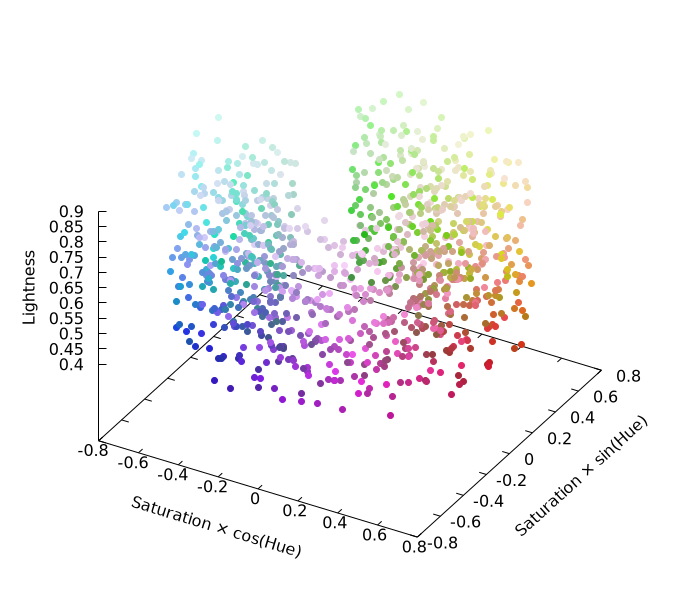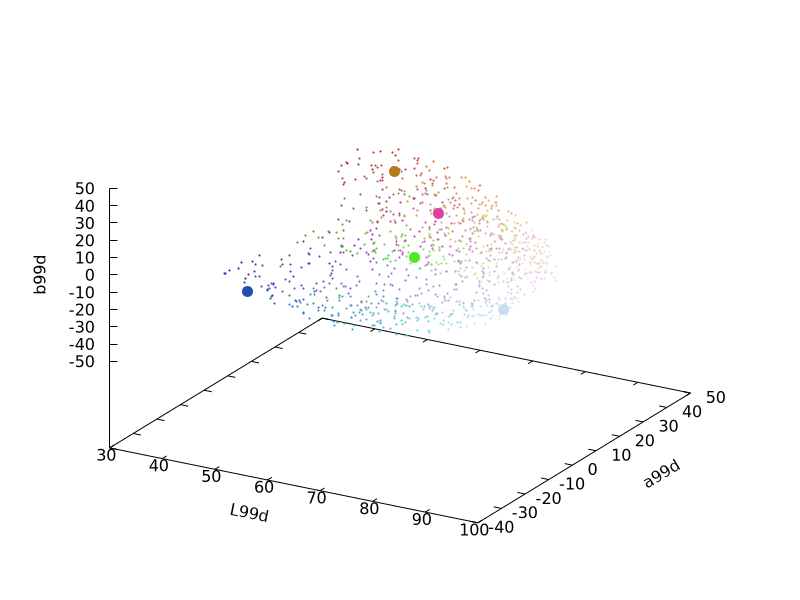|
qualpal 3.3.0
|
|
qualpal 3.3.0
|
qualpal is designed to generate perceptually distinct color palettes. It does so by starting wit a set of input (candidate) colors, which can be either
"ColorBrewer:Set2"In case of the second option, using the HSL color space, qualpal uses a Halton pseudo-random sequence to distribute colors evenly in the specified color space, ensuring a uniform distribution of colors across the hue, saturation, and lightness dimensions.

The next step is to figure out which of the candidate colors are maximally distinct from each other. To do so, we first need to measure the distances between all candidate colors.
In order to figure our which colors are maximally distinct, qualpal constructs a distance matrix that contains the pairwise distances, in terms of some color difference metric, between all candidate colors. By default, qualpal uses the CIEDE2000 metric, which is current standard of the International Commission on Illumination (CIE) for color difference measurement.
Since this formula is quite complex, however, there is alternative metrics. For instance, qualpal also includes the possibility to use the DIN99d metric (Cui et al. 2002), which is based on simple Euclidean distance in the DIN99d color space. In this case, the candidate colors are projected into the DIN99d color space, which is a perceptually uniform color space, which means that the Euclidean distances between colors in this space correspond to the perceived color differences. This makes computing the full color difference matrix efficient. To further improve the distance metric, we also apply a power function to the computed distances, as suggested by Huang et al. (2015).

The problem of selecting a set of points (in our case colors) that are maximally distinct is known as the max-min \(k\)-dispersion problem, which is NP-hard. Even for, say, a required palette of 10 colors and 100 candidate colors, solving this problem exactly would be intractable.
Instead, qualpal uses a heuristic algorithm based on the basic idea of farthest point sampling in (Schlömer et al. 2011).
Letting n be the desired size of the palette and m, the algorithm works as follows:
Iteratively, we put one point from our current palette (P) back into the candidate set (C) and check all distances between the points in C to those in P to find the point with the maximum minimum distance. We continue until P does not change (which is guaranteed to happen eventually), which means that none of the candidate points were able to provide an improvement. Let's see how this works on the same data set we used above.
The algorithm is guaranteed to converge, and the result is a set of colors that are (approximately) maximally distinct from each other, according to the computed distance matrix.
For the running example, the algorithm would select the following colors.

You can see the computed color palette in the following image.

As far as the complexity of the algorithm is concerned, it is
A key feature of qualpal is the ability to generate color palettes that are accessible to people with color vision deficiencies (CVD). To do so, qualpal simulated the effects of CVD on the input (RGB) colors by applying a color vision deficiency model from Machado et al. (2009). This model simulates the effects of protanopia, deuteranopia, and tritanopia (or any combination of these) on the input colors, with selected severity. The color difference matrix is then computed on the simulated colors, ensuring that the resulting palette is accessible to people with CVD.
The motivating example for qualpal was to generate color palettes for visualization of categorical data, in which case there is typically a background color to consider as well. If the colors are too bright, then they may not be visible against or dinstinc enough from the background color. qualpal therefore also supports specifying a background color, which ensures that the selected colors are distinct from the background color as well.
One thing that qualpal does not do is to consider aesthetic considerations when selecting colors. It has no notion of color harmony, complementary colors, or any other aesthetic considerations. The focus is purely on maximizing the perceptual distinctiveness of the selected colors.
If aesthetic considerations are important, however, then it is also possible to use qualpal to improve on existing color palettes, for instance by taking a predefined color palette (such as "ColorBrewer:Set2"), and tweaking it by picking out (and ordering) the \(n\) most distinct colors as well as ensuring that the colors are distinct from a given background color and accessible to people with color vision deficiencies.
Since input in hex format is supported, it is also easy to use qualpal on any existing color palette outside of the library.